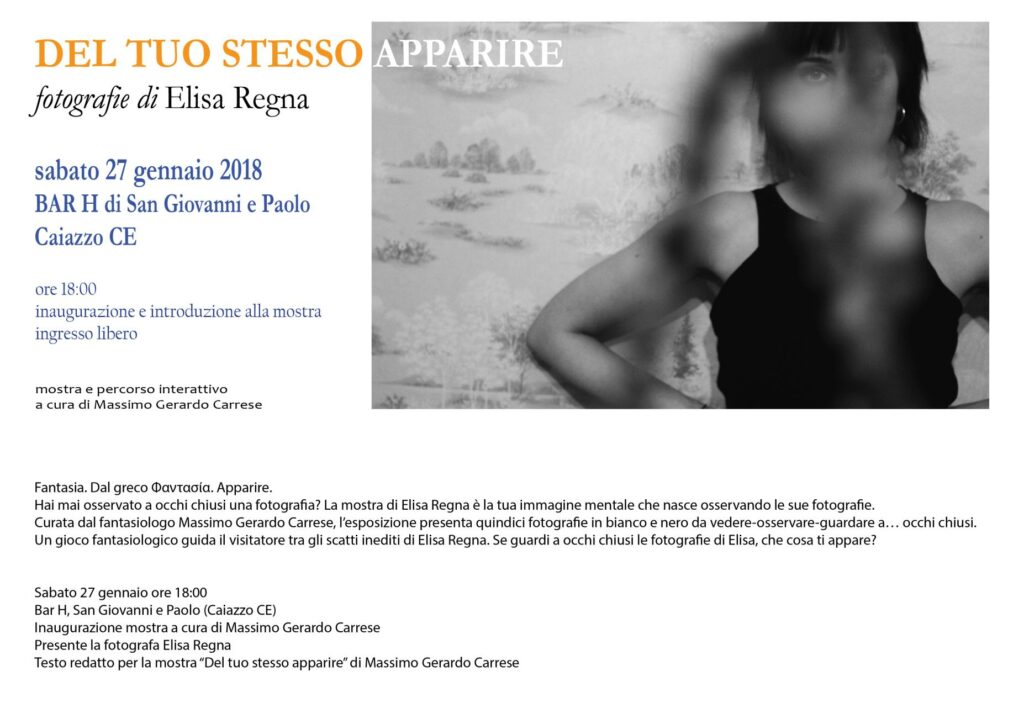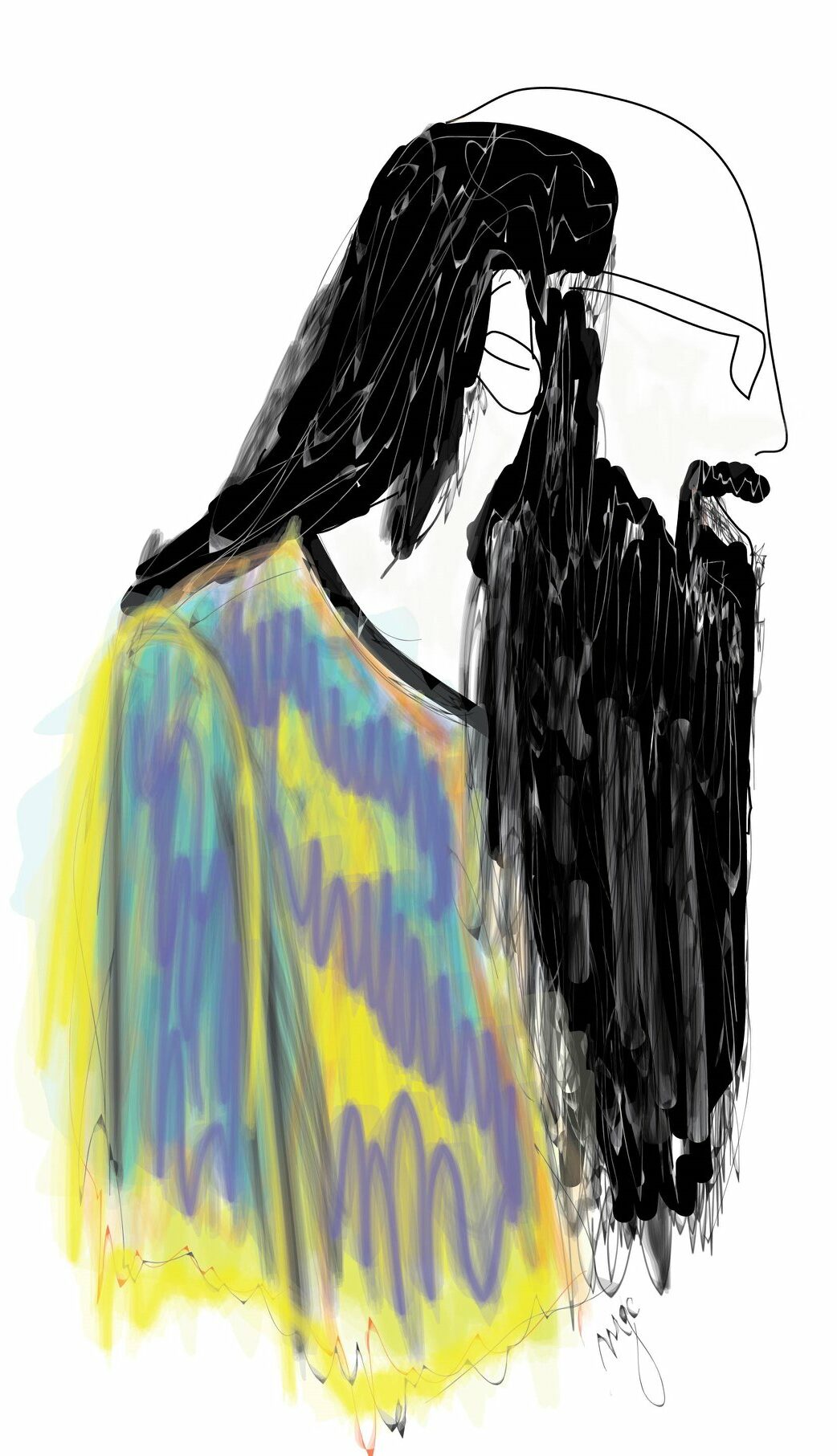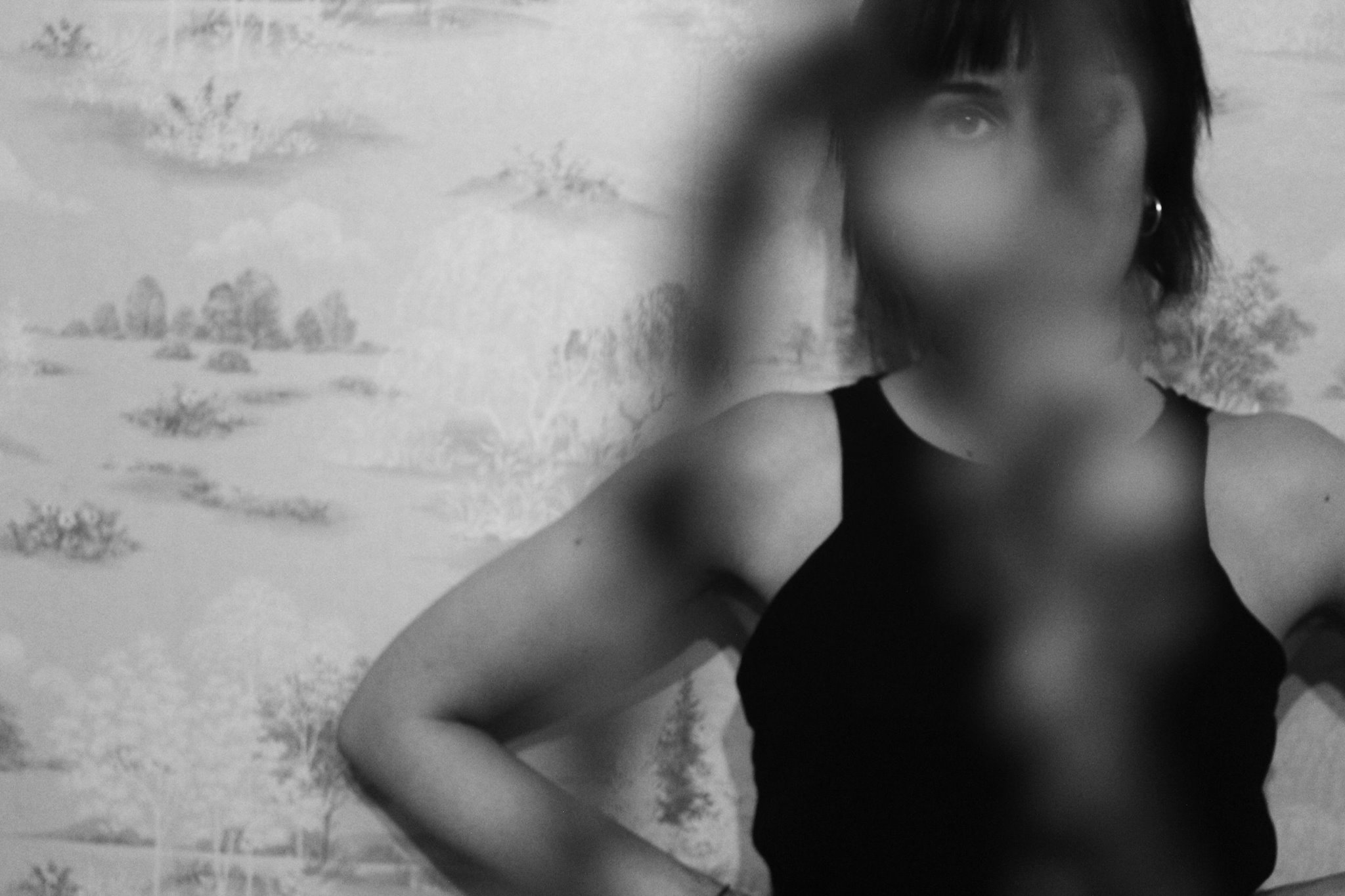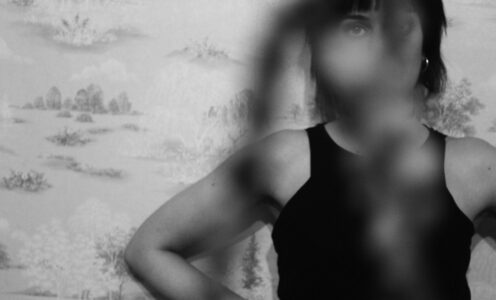Del tuo stesso apparire
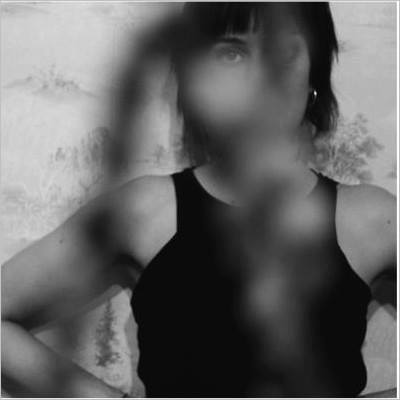
Fotografia di Elisa Regna
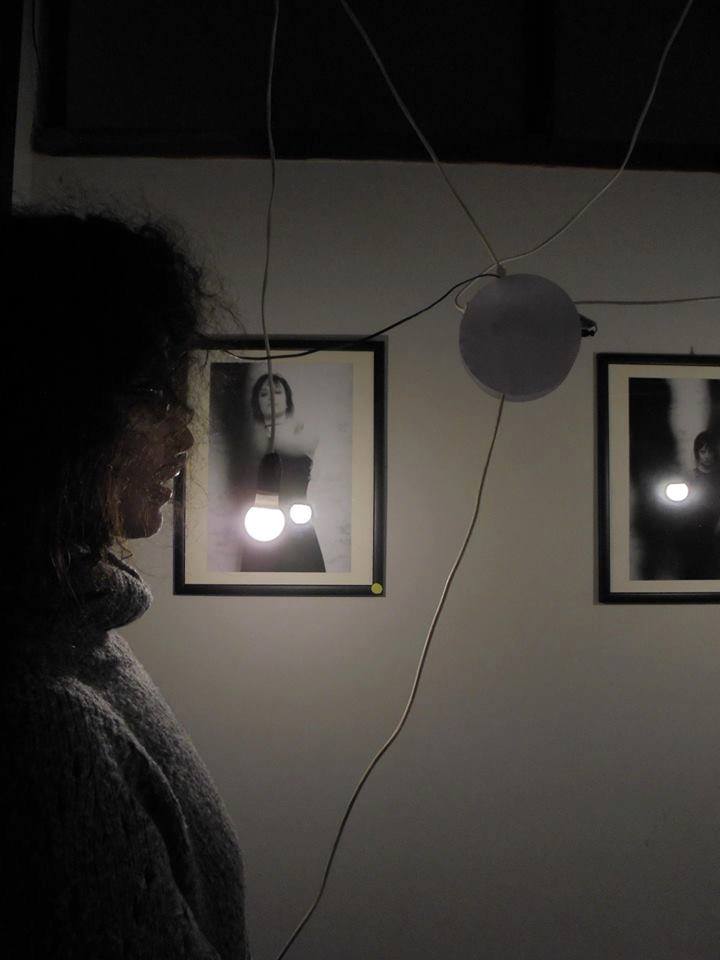
“[…] A occhi aperti vedi la fotografia e l’ambiente in cui sei (anche se ognuno vede quello che vuole guardare). A occhi chiusi continui a vedere nella tua mente la stessa fotografia e lo stesso ambiente in cui ti trovi però le informazioni sono più sfocate e l’immagine esterna diventa dentro di te anche altro. La mostra di Elisa Regna è la tua immagine mentale che nasce osservando le sue fotografie. […]” [1]
Artribune, gennaio 2018
[…] Elisa Regna mette in mostra quindici fotografie in bianco e nero. Inedite. Pensate per farsi guardare attraverso un gioco fantasiologico ideato dallo studioso di storie e caratteristiche della fantasia e dell’immaginazione, il fantasiologo Massimo Gerardo Carrese, curatore della mostra. […]
Rivista Segno, gennaio 2018 [2]
OGGETTO E SOGGETTO
Quindici fotografie. In bianco e nero. Elisa Regna [3] ritrae, al contempo, un oggetto e un soggetto. In ogni fotografia “la cosa” – sfocata – è in primo piano; la donna (Giovanna Prata [4])- in uno scatto mosso – è sullo sfondo. E tu sei l’osservatore, non solo delle fotografie ma delle tue immagini mentali.
A Elisa chiedo di preparare quindici fotografie per la mostra fantasiologica, con un vincolo artistico: frapporre fra l’obiettivo della macchina e la modella un oggetto a scelta ma sempre sfocato.
In queste fotografie c’è un primo piano, “la cosa”, e uno sfondo, la donna. Tal equilibrio fotografico è fedele anche a una certa etimologia (senza addentrarci in questioni filosofiche) che rivela in Objèctum ciò che è “posto di fronte” e in Subjèctum ciò che è “posto sotto”, nella nostra rilettura, sullo sfondo.
RACCONTARE E PERCEPIRE
Le fotografie esposte non raccontano una storia. Ogni scatto in mostra è l’indispensabile causa scatenante delle tue percezioni mentali, secondo il gioco fantasiologico di contesto. Ogni fotografia di Elisa Regna genera una percezione cosicché la mostra non racconta le immagini esposte ma le tue immagini mentali che nascono dalle sue immagini esposte.
A OCCHI APERTI – A OCCHI CHIUSI
Il gioco suggerisce postazioni e indicazioni di tempi d’osservazione. Sul pavimento, nello spazio espositivo, trovi due numeri (1 e 2) da cui iniziare il percorso e dei punti colorati che potrai scegliere a tuo piacere. Ogni colore/numero è associato a una fotografia. Metti i tuoi piedi su un punto colorato/numero e cerca con lo sguardo la fotografia associata a quel colore/numero. Guarda la fotografia da quella postazione. Guarda solo quella fotografia. Guardala dove desideri e fallo per quindici secondi (quindici sono gli scatti in mostra) dalla posizione in cui ti trovi. Poi chiudi gli occhi. Tienili chiusi senza far pressione sulle palpebre né arricciare la fronte. Resta fermo dove sei. Ecco, adesso dovresti vedere nella tua mente un’immagine, anche solo di sfuggita. Definita o incerta, una sagoma o un colore, l’immagine che ti appare dipende solo da te. Non c’è niente di spirituale in questo discorso. È una questione fisiologica: il nostro cervello è predisposto a formare/alterare immagini da stimoli esterni e interni, al di là del senso che diamo a queste immagini. Nella mostra ci concentreremo sulle immagini mentali che si formano da stimoli esterni, le fotografie.
A occhi aperti vedi la fotografia e l’ambiente in cui sei (anche se ognuno vede quello che vuole guardare). A occhi chiusi [5] continui a vedere nella tua mente la stessa fotografia e lo stesso ambiente in cui ti trovi però le informazioni sono più sfocate e l’immagine esterna diventa dentro di te anche altro. La mostra vive di questo anche. Le luci dell’ambiente espositivo e quelle diurne contribuiscono a costruire le fantasmagorie nella tua mente. Dopo aver giocato con la tua immagine mentale riapri gli occhi. Batti le palpebre, con leggerezza, e guarda la stessa fotografia ancora per un po’ e poi passa a un altro scatto.
“Del tuo stesso apparire” è, insieme, un’esposizione fotografica e un’installazione luci che invitano a una visione dell’immagine in tre momenti:
– naturale: la vista come senso (vedere);
– chimerico (guardare): quando chiamiamo in gioco la nostra esperienza. Questo accade quando guardiamo una fotografia pensando alle sensazioni che essa ci dà, se ci piace, se non ci piace, se ci ricorda qualcosa, se ci riporta a un’altra immagine; quando pensiamo alla tecnica di composizione, alle nostre emozioni, ecc. In particolare, lo sguardo chimerico è quando vediamo un’immagine ma guardiamo altrove;
– a occhi chiusi: che cosa ci appare quando vediamo e guardiamo una fotografia e poi chiudiamo gli occhi?
Durante l’inaugurazione della mostra, le persone che partecipavano al gioco e che guardavano a occhi chiusi [6] le fotografie, hanno raccontato, nel vivo delle loro esperienze, di aver avuto le seguenti apparizioni: un piede, un fiume che scorre, una ballerina, una finestra-cancello, un elefante, una spirale, una sfera azzurra danzante, una pergamena, una torre di un castello, un colore, un viale alberato, una cornice dorata….Le fotografie esposte, voglio precisare, non ritraggono le immagini o le caratteristiche sopra elencate. [7]
LA TUA IMMAGINE
La mostra di Elisa Regna non riguarda direttamente le fotografie esposte. La mostra è la tua immagine mentale che nasce osservando le sue fotografie. A seconda delle tue suggestioni, un braccio appena visto può mutare a occhi chiusi in una rosa; il collo della modella diventare rosso; la linea dell’oggetto trasformarsi nel profilo di un topolino. In questo discorso c’entra la complessità del nostro cervello di fare associazioni, di immaginare, di fantasiare, di creare, di definire la realtà. E c’entra la scienza, l’esperienza, la distrazione…. A vedere non è l’occhio, ma il cervello: lo capirono Galilei, Keplero e poi, tra gli altri, Kuhn.
VISIBILE – INVISIBILE
«L’arte, ha scritto una volta un filosofo che si chiama Agamben, non serve per rendere visibile l’invisibile, serve per rendere visibile il visibile, e questa cosa, con l’Emilia, a me è successa grazie alla fotografie di Luigi Ghirri, avevo detto. Prima di vedere le fotografie di Luigi Ghirri, se pensavo all’Emilia io, oltre che al ballo liscio, al lambrusco e ai tortellini, pensavo a poche cose, ai pioppi e al fiume Po, prevalentemente; c’erano queste immagini abusate che non avevano niente a che fare con le mie giornate, abito lontano dai pioppi e dal Po, ma che erano da qualche parte nella mia testa dentro una cartellina con su scritto “Emilia”. Dopo che ho visto le fotografie di Ghirri, io mi sono accorto che in Emilia ci sono anche i distributori di benzina, i semafori, le fermate dell’autobus, la neve, i bambini che si vestono da Batman per carnevale, i gommisti, le saracinesche, le pubblicità, il cielo. Lui, Ghirri, con le sue fotografie, è come se avesse preso con due dita l’imballaggio che avvolgeva l’Emilia, sotto casa mia, e avesse tolto dal loro imballaggio che li rendeva invisibili i distributori di benzina, i semafori, le fermate dell’autobus, la neve, i bambini che si vestono da Batman per carnevale, i gommisti, le saracinesche, le pubblicità e il cielo che c’erano sotto casa mia e io adesso, è incredibile, riesco a vederli, e la cosa è ancora più incredibile se si considera che Ghirri, sotto casa mia, probabilmente, non c’è mai neanche passato.» [8]
La fotografia in bianco e nero di Elisa Regna adotta un procedimento che ricerca l’invisibile nel visibile e, in questo gioco fantasiologico, viceversa. Forme, dinamicità, colori e altre caratteristiche delle immagini mentali dipendono solo da noi e da come desideriamo giocare con le nostre apparizioni. Visitatore: guarda, come suggerito, le fotografie di Elisa e poi chiudi gli occhi. Che cosa ti appare, se ti appare?
INSTALLAZIONE LUCI
Ho studiato nel tempo tutta l’installazione secondo le misure dello spazio espositivo. In un solo pomeriggio ho montato tutto. Una scelta ragionata delle lampadine da 15w: sei lampadine a luce calda e una lampadina a luce fredda; una lampadina calda a incandescenza da 20w; una lampada stroboscopica che si accendeva con un timer su una specifica fotografia ogni quindici minuti; una lampadina pendente, funzionante ma spenta. Ogni lampadina ha uno specifico ruolo nelle apparizioni. Vari metri di fili elettrici e di stoppa. Varie prese elettriche… tutto montato a vista. Tutto è ben visibile, a te visitatore. Talvolta una musica in sottofondo accompagna i tuoi passi. [9] Probabilmente, ti chiedi il motivo di quest’installazione così artigianale e sfacciatamente a vista: è per mostrarti che non ci sono artifici nel gioco delle tue apparizioni se non quelli generati dalla tua stessa mente.
Qui la fantasia si nutre del greco Φαντασία: apparizione.
Vai a TUTTE LE PUBBLICAZIONI
[1] HTTP://WWW.ARTRIBUNE.COM/MOSTRE-EVENTO-ARTE/ELISA-REGNA-DEL-TUO-STESSO-APPARIRE/
[2] HTTPS://WWW.RIVISTASEGNO.EU/EVENTS/DEL-TUO-STESSO-APPARIRE/
[3] FOTOGRAFA DI RIARDO (CASERTA).
[4] DI ROCCAMONFINA (CASERTA)
[5] SAPEVI CHE CI SONO PERSONE CHE NON RIESCONO A VISUALIZZARE IMMAGINI MENTALI? AFANTASIA. È UNA CONDIZIONE NEUROLOGICA CHE EVIDENZIA L’INCAPACITÀ DI VISUALIZZARE IMMAGINI MENTALI. NEI CASI PIÙ COMPLESSI RIGUARDA UNA “CECITÀ MENTALE” CHE COINVOLGE SUONI, SAPORI, ODORI… (CFR. ADAM ZEMAN IN “CORTEX”, VOL. 73, 2015, 378-380 E, PRIMA, FRANCIS GALTON – 1880 “STATISTICS OF MENTAL IMAGERY”- “MIND”, 5, 301-318). LE RICERCHE SULL’ARGOMENTO SONO ANCORA IN CORSO.
[6] LA MOSTRA CHE HO CURATO REGGEVA TUTTO SUL MOMENTO “A OCCHI CHIUSI”, STRUTTURATO SECONDO UN DISEGNO LUCI E UN PERCORSO IDEATO DOPO ALCUNE MIE RICERCHE SULLE IMMAGINI MENTALI. TUTTAVIA, LE FOTOGRAFIE ESPOSTE POTEVANO ESSERE VISTE E GUARDATE AL DI LÀ DI QUEST’INTENZIONALITÀ ANGANTASIOLOGICA.
[7] VIDEO DI ALCUNI MOMENTI DELLA MOSTRA: HTTPS://WWW.YOUTUBE.COM/WATCH?V=H6N0SIE6RLQ
[8] HTTP://WWW.PAOLONORI.IT/ARGOMENTI/LUIGI-GHIRRI/
[9] UNIQUE – SONATA UNICA PER PIANOFORTE A CODA DI MASSIMO GERARDO CARRESE, NGURZU EDIZIONI 2006
Il testo è un riadattamento dello scritto presentato in occasione della mostra al Bar H di San Giovanni e Paolo (Caiazzo – CE), dal 27 gennaio al 27 febbraio 2018. Ringrazio Angela Tascillo e Franco Di Salvatore del Bar H che hanno accolto l’iniziativa con sincero entusiasmo.
* tratto da ArteCulturaItaloPolacca. Dalla rubrica “Grilli Per la Testa” – 09/04/2018
Of your own appearance
With your eyes opened, you see the photograph and the environment you are in (although everyone sees what they want to see). With your eyes closed, you still see the same photograph and the same environment you are in, but the information is more blurred and the external image becomes something else inside you. Elisa Regna’s exhibition is your mental image that is created when you look at her photographs. […]” [1]
Artribune, January 2018
Elisa Regna exhibits fifteen black and white photographs. Unpublished. Designed to be viewed through a fantasiological game conceived by the scholar of stories and characteristics of imaginary and imagination, the fantasiologist Massimo Gerardo Carrese, curator of the exhibition. […]
Rivista Segno, January 2018 [2].
Object and Subject
Fifteen photographs. In black and white. Elisa Regna [3] portrays an object and a subject, at the same time. In each photograph “the thing” – blurred – is in the foreground; the woman (Giovanna Prata [4]) – blurred – is in the background. And you are the observer, not only of the photographs, but of your mental images.
I ask Elisa to prepare fifteen photographs for the fantasiologic exhibition, with an artistic constraint: to place an object between the camera lens and the model, but always out of focus.
In these photographs there is a foreground, “the thing”, and a background, the woman. This photographic balance is also faithful to a certain etymology (without going into philosophical questions), which reveals in Objèctum what is placed “in front” and in Subjèctum what is placed “underneath”, in our reinterpretation, in the background.
Telling and perceiving
The photographs in the exhibition do not tell a story. Each photograph in the exhibition is the essential trigger of your mental perceptions, according to the fantasiologic game of context. Each of Elisa Regna’s photographs generates a perception, so that the exhibition does not tell the story of the images on display, but of your mental images that arise from them.
With eyes opened – With eyes closed
The game suggests places and times to look. On the floor, in the exhibition space, you will find two numbers (1 and 2) from which to start your journey and coloured dots that you can choose at will. Each colour/number is associated with a photograph. Place your feet on a coloured dot/number and look for the photograph associated with that colour/number. Look at the photo from that spot. Look at that photo only. Look at it wherever you like for fifteen seconds (fifteen shots are hosted by the exhibition) from the position you are in. Then close your eyes. Keep them closed without pressing your eyelids together or wrinkling your forehead. Stay where you are. You should now see an image in your mind, even if it is just a glimpse.
Defined or indeterminate, a silhouette or a colour, the image that appears to you is entirely up to you. There is nothing spiritual about it. It is a physiological matter: our brains are predisposed to form/alter images from external and internal stimuli, beyond the meaning we give to these images. In the exhibition we will focus on mental images formed from external stimuli, photographs.
With your eyes opened, you see the photograph and the environment you are in (although everyone sees what they want to see). With your eyes closed [5] you still see the same photograph and the same environment you are in, but the information is more blurred and the external image becomes something else inside you. The exhibition also lives from this. The light of the exhibition environment and the light of the day help to build the phantasmagoria in your mind. After playing with your mental image, open your eyes again. Blink lightly and look at the same photograph for a while before moving on to another.
“Of Your Own Appearance” is both a photographic exhibition and a light installation, inviting us to look at the image in three moments:
– natural: sight as a sense (seeing);
– chimerical: when we bring our experience into play. This happens when we look at a photograph and think about the sensations it gives us, whether we like it, dislike it, whether it reminds us of something, whether it takes us back to another image; when we think about the composition technique, our emotions, etc. In particular, the chimeric gaze is when we see a picture but “look” somewhere else;
– closed eyes: what does it look like to us when we see and look at a photograph and then close our eyes?
At the opening of the exhibition, people who took part in the game and looked at the photographs with their eyes closed [6] told of their experiences of the following apparitions: a foot, a flowing river, a ballerina, a window frame, an elephant, a spiral, a dancing blue ball, parchment, a castle tower, a colour, a tree-lined avenue, a golden frame…. The photographs shown, I would like to point out, do not depict the images or features listed above. [7]
Your image
Elisa Regna’s exhibition is not directly about the photographs in the exhibition. The exhibition is about your mental image that is created when you look at her photographs. Depending on your suggestions, an arm you have just seen may turn into a rose; the model’s neck may turn red; the line of the object may become the profile of a mouse. It has to do with the complexity of our brain to elaborate associations, to imagine forms and possibilities, to create, to define reality. And it has to do with science, experience, distraction…. It is not the eye that sees, but the brain: Galileo, Kepler and then Kuhn, among others, understood this.
Visible – Invisible
“Art, a philosopher called Agamben once wrote, does not serve to make the invisible visible, it serves to make the visible visible, and this thing, with the Italian region Emilia Romagna, happened to me thanks to Luigi Ghirri’s photographs, I said. Before I saw Luigi Ghirri’s photographs, when I thought about Emilia, apart from ballroom dancing, lambrusco and tortellini, I thought of a few things, mainly poplars and the River Po; there were these overused images that had nothing to do with my days, I live far from poplars and the River Po, but they were somewhere in my head in a folder with “Emilia” written on it. After seeing Ghirri’s photographs, I realised that in Emilia there are also petrol stations, traffic lights, bus stops, snow, children dressed up as Batman for carnival, tyre dealers, shutters, advertisements, the sky.
He, Ghirri, with his photographs, it’s as if he had taken two fingers from the wrapping that enveloped Emilia, where I live, and removed from their wrapping that made them invisible the petrol stations, the traffic lights, the bus stops, the snow, the children who dress up as Batman for carnival, the tyre dealers, the shutters, the advertisements and the sky that were there at my house and I can now, it’s incredible, see them, and it’s even more incredible if you consider that Ghirri, near my house, probably never even passed by.” [8]
Elisa Regna’s black and white photography uses a technique that seeks the invisible in the visible and, in this fantasiologic game, vice versa. Shapes, dynamics, colours and other characteristics of mental images depend only on us and how we want to play with our appearances. Visitor: Look at Elisa’s photographs as suggested and then close your eyes. What, if anything, do you see?
Light design
I studied the entire exhibition installation over time according to the measurements of the exhibition space. I put it all together in just one afternoon. A precise choice of 15w light bulbs: six warm bulbs and one cold bulb; a 20w warm light bulb; a stroboscopic bulb that switched on every fifteen minutes with a timer on a specific photograph; a pendant bulb that worked but was switched off.
Each light bulb had a specific role in the apparitions. Various metres of electrical wires and cables. Various electrical sockets… all mounted in full view. Everything is clearly visible to you, the visitor. At times, background music accompanies your footsteps [9]. You are probably wondering why this installation is so elaborate and blatant: it is to show you that there are no tricks in the play of your apparitions other than those created by your own mind.
Here imagination feeds on the Greek Φαντασία: appearance.
